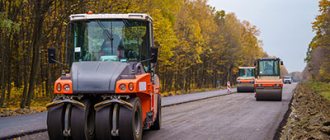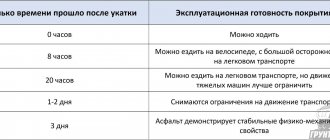Beton-House.com
Website about concrete: construction, characteristics, design. We combine the experience of professionals and private craftsmen in one place
A slight smoke above the surface indicates the high temperature of the asphalt concrete
There are no mysteries or tricks when laying ready-made asphalt concrete. Evenly distribute the hot mass 5-7 cm thick over a given area, check the level of coverage in accordance with SNiP 3.06.03-85 and you can hand over the work. The compaction of the asphalt concrete mixture determines the quality of the work performed.
The coating mass is obtained artificially and must be well compacted. How to obtain the required density of asphalt concrete, at what construction sites is this indicator relevant, and how is it determined?
- Density Measurement and Meters
Components of asphalt concrete, its types
Asphalt concrete is a building material obtained by compacting an asphalt concrete mixture, which, in turn, is composed of rationally selected mixtures of mineral powder, sand, crushed stone, and bitumen.
Production of cast asphalt concrete
Methods for producing asphalt concrete mixtures are very diverse:
- Splitting up;
- Heating;
- Drying;
- Mixing.
Types of mineral components subdivide asphalt concrete:
- On sandy ones;
- Gravel;
- Crushed stone.
The size of mineral grains determines asphalt concretes as:
- Sand grains up to 10 mm;
- Fine-grained up to 20 mm;
- Coarse-grained up to 40 mm.
The scope of application of coarse-grained porous asphalt concrete mixture is varied:
- In two-layer asphalt paving, it is used as the bottom layer;
- With high-quality, effective compaction of the canvas, single-layer installation is allowed;
- Reconstruction and full repair of roads;
- Laying coatings in the parking area;
- Arrangement of courtyard paths and areas for various purposes.
The characteristics of a dense, coarse-grained asphalt concrete mixture are distinguished by the fact that it allows you to obtain:
- Residual porosity from 5 to 10%;
- Temperature during loading 150ᵒС;
- Coarse-grained dense asphalt concrete is characterized by high resistance to dynamic and statistical loads, subject to the presence of inert additives and crushed stone up to 60%.
If we compare its strength qualities with other mixtures, then it is incomparably higher than fine-grained and sandy materials.
Attention: Coarse-grained road asphalt concrete, the density of which has been increased due to the addition of inert fine fractions, has much greater resistance to the penetration of water into the coating than without them.
It is impossible to completely exclude the presence of porosity in these asphalt concretes.
Asphalt concrete is divided into the following types:
| Varieties | Purpose | Raw material | Laying temperature |
| warm | permanent road coverings, for the installation of lower layers of coatings | liquid bitumen SG130/200. 70/130, petroleum road bitumens (BND) 200/300, 130/200, limestone powder, durable slag, crushed stone, sand | not less than 70ᵒС |
| hot | For laying the top and bottom layers of highways, used in the spring, in the 3rd road-climatic zone | crushed granite stone, quartz river sand, limestone mineral powder BND 90/130 | not less than 120ᵒС |
| cold | Pothole repairs in small areas, elimination of damage to the road surface at the initial stage, ensuring safe traffic in emergency areas | D-4, D-5 crushed mineral material with angular grain shape and rough surface, crushed stone, bitumen viscosity depends on the planned storage period, mineral components, air temperature | not less than 5ᵒС |
If possible, laying asphalt concrete is carried out in warm weather. In spring, when the air warms up to +5ᵒC, in autumn at +10ᵒC, with the exception of urgent and emergency repair work.
Composition of asphalt and its varieties
There are many types of roads for travel. They all have different loads, which is why the quality of the coating varies within certain limits. So, roads can be designed:
- For pedestrians - sidewalks, parks, squares, squares, recreation areas, pedestrian bridges.
- For cyclists - walking paths in parks, along highways, cycling tracks in stadiums.
- For car owners - two to eight lane highways, parking lots, bridges.
The pavement density for pedestrian paths is the lowest due to the relatively small load per square meter. As the load increases, the content of reinforcing materials in asphalt concrete increases.
There are the following types of asphalt depending on their composition and origin:
- Natural asphalt . It is a specific resinous solid mass, which consists of oils and resinous substances and has a rather low melting point - 20-100 ° C. It is formed under natural conditions by evaporation of the light fraction of oil in places where it is shallow or reaches the surface. When hardened, its heavy part mixes with gravel, sand and other mineral components and forms a crust of varying density. The average value of this value is 1−1.2 t/m 3.
- Artificial asphalt is called asphalt concrete - it is a mixture of mineral components on a bitumen base. It includes crushed stone, gravel, sand and mineral powder. Also, to impart special properties, crumbled rubber obtained from the industrial processing of old car tires and other products can be added to asphalt. However, rubber asphalt is very expensive compared to regular asphalt, so it is used rarely and within modest limits. The weight of the asphalt concrete mixture in 1 m3 can reach 2.5 tons.
Types of asphalt pavement differ in composition, laying temperature, hardness and service life. For example, so-called cold asphalt is often laid - this type of road surface can be worked without preheating. In addition, it does not require additional technical equipment - such asphalt does not need to be rolled, it is enough to simply distribute it evenly over the required area. It is made from environmentally friendly ingredients and includes limestone powder, which serves as an excellent plasticizer.
Cast asphalt, in addition to an increased amount of natural plasticizing powders, also contains a large amount of high-viscosity resin, which makes it a high-quality material for laying roads. It has a high strength coefficient, resistance to water and chemicals, does not collapse under the influence of temperature changes and provides good wheel traction. In addition, the molded coating suppresses noise and is easy to repair. However, all these positive qualities are somewhat reduced by the high price of equipment for its installation. Hot artificial asphalt consists primarily of crushed stone and uses crude petroleum products for binding. Such coating requires mandatory heating and compaction with special rollers. It is considered the most common and is used for laying the underlayer of state and regional highways, as well as for runways and other high-traffic facilities.
The next layer of coating can be coarse asphalt, which includes large asphalt chips, which are obtained by crushing the old road surface. It also has a rigid structure and makes a good base for a fine grain topcoat.
Asphalt granulate and asphalt chips are used to strengthen the asphalt surface instead of conventional crushed stone - these materials are obtained by recycling, so they are much cheaper.
Calculation of density according to the table
There is the following classification of road “clothing” depending on the type of coating, composition and specific gravity of asphalt concrete. The table can be used when calculating the required quantity for road repair or new construction.
Compaction determines the quality of the coating
Compaction of asphalt concrete triggers the processes of rearrangement of mineral particles and their convergence. The trapped air is partially displaced, the bitumen is redistributed throughout the mixture, filling the voids formed between the grains.
The asphalt concrete mixture is compacted after laying at the highest possible temperature, when the roller is no longer able to move it.
The required density of the asphalt concrete mixture, strength and water resistance of the coating are acquired as a result of compaction.
- The quality of work is ensured by performing the minimum required number of passes with rollers;
- Compliance with temperature conditions at each stage: preliminary, intermediate, final
Attention: The roller can “sink” on mixtures with high temperatures, and rolling a cooled mixture is not only useless, but also harmful, because crushed stone destruction is possible
Temperature indicators of the seal:
| Stages | Mixture temperature by type | ||||
| A | B | IN | G | D | |
| Preliminary | 145-140 | 135-130 | 125-120 | 130-125 | 110-105 |
| Basics | 125-120 | 115-110 | 105-100 | 110-105 | 90-85 |
| Final | 100-95 | 95-90 | 85-80 | 90-85 | 75-70 |
| The end of the last, final stage | 80-75 | 75-70 | 65-60 | 75-70 | 60-55 |
Possibilities of modern technology
The modern market is represented by different models of rollers, both domestic and foreign. Selecting the right equipment has become easier on the one hand, and more difficult on the other. The size of the equipment depends on its capabilities.
Attention! What is the most important thing when choosing the technical characteristics of a unit? Machine performance at different mixture heights, dense asphalt concrete and its thickness.
The video in this article offers recommendations from experts who define the different types of machines used in compacting asphalt concrete mixtures.
Static self-propelled roller DM-13-SD
The static roller operator must know how to obtain the required density of the dense asphalt concrete mixture and the technical requirements for quality
- Serves to compact bitumen-containing mass, the thickness of which does not exceed 25-50 mm;
- This unit was called a tandem machine. Has built-in drive and steering rollers;
- The strength of the coating is achieved by adjusting the ballasting processes before compaction begins;
- The weight of the machines varies between 6-12 tons/force.
JCB twin drum vibratory roller
Compacting asphalt concrete with Atlas Copco LG400DEC vibrating plates
- Used for compacting sand, soil, crushed stone, asphalt;
- Diesel, reversible vibrating plate, equipped with a compaction indicator, is intended for work on non-cohesive soils (gravel, sand);
- For compacting mixed granular soils (crushed stone with sand), (stone, coarse crushed stone);
- Its small dimensions allow you to work in the most cramped spaces.
The required density of the porous asphalt concrete mixture is achieved using a BOMAG pneumatic roller
Machines for high volume compaction
The unusual design of the unit, special tires, and optimal pressure on the compacted area make it possible to obtain high quality compaction.
One glance is enough to appreciate the advantages of the unit:
- Greater maneuverability and mobility;
- High speed and large work area;
- Weight adjustment from 9 to 27 tons;
- Proper surface treatment;
- Ease of operating the unit.
Using the chosen technique, you can compact any surface, both large and small.
Minimum compaction rate
The problem of obtaining the minimum required standard coefficient of compaction of asphalt concrete has been and remains relevant for both Soviet and Russian road contractors. Why is the minimum standard of interest to road builders, and not higher?
According to the current SNiP 3.06.03-85, the compaction coefficient of asphalt concrete in Russia is expressed in fractions of 1.0, in foreign countries in fractions of 100%. The essence does not change from this, both for us and for them, for asphalt concrete pavements of type A, B, the density indicator should be equal to 0.99 or 99%, 0.98, 98% for type C, D, D.
The compaction coefficient of an asphalt concrete mixture is determined by dividing the achieved density and the calculated one. Analysis of the compacting ability of domestic and foreign rollers of those years, available to most road workers, according to modern criteria shows functional inferiority. Therefore, expecting a seal of higher quality from such technology than the minimum declared is naive and incompetent.
An independent road survey conducted in the 60-70s by SoyuzdorNII, in the European part of the USSR, found that the average pavement service life barely reached 2/3 of the service life of foreign roads. Today, domestic road builders have gained experience, mastered modern technologies, received effective equipment, including compaction, and we can only hope that good roads will be built here in this century.
Asphalt consumption calculator per m2
To calculate the amount of asphalt concrete mixture, it is very convenient to use an asphalt consumption calculator. Thanks to its functionality, you can determine the consumption of any type of asphalt in a matter of seconds. An online asphalt consumption calculator will help you calculate the tonnage of asphalt based on data on thickness, volume and type of mixture. It not only allows you to calculate the asphalt consumption per 1 m2, but also helps determine the amount of mixture for any area. You can specify the thickness of the coating with an accuracy of 0.5 cm (for example: 4.5 cm). The calculator can also calculate the consumption of cold asphalt. Therefore, if you need to find out how much cold asphalt is required, you can use the cold asphalt consumption calculator.
Density indicator
Determining the density of an asphalt concrete mixture remains one of the main characteristics of the material.
Attention: Samples are removed from layers of hot/warm coatings after 1-3 days, and from cold layers - after 15-30 days
The process of new construction or road repair requires constant monitoring of the condition and quality of asphalt concrete.
The instructions prescribe to organize the work in 2 stages using the destructive method:
- The preparatory period, when the area where the sample will be removed must be clean;
- The sample is cut down in one piece, without chips; the presence of a network of cracks is not allowed.
- Samples are taken over the entire thickness of the coating, regardless of the number of layers;
- The selection of an area measuring 0.5×0.5 m for collecting cores is carried out according to certain rules. The cutting distance is at least 0.5 m from the edge or axis of the road.
- The main work is when the mass of cores is determined: sand mixtures - 1 kg with a diameter of 50 mm, fine-grained - 2 kg D = 70 mm, coarse-grained - 6 kg D = 100 mm,
- The samples are marked, numbers are assigned, and a selection report is filled out, where all the coordinates of the object, contractor, and picket number are indicated.
- Samples are taken at three points from 700 m² of laid area.
The non-destructive testing method uses radioisotope testing, electromagnetic and ultrasonic testing. With these methods there is no need to damage the thickness of the coatings and it is possible to obtain operational data.
Asphalt consumption rate per m2
To determine the rate of asphalt consumption per m2, you need to know the thickness of the asphalt and the type of asphalt concrete mixture. Each type of asphalt has its own density and, therefore, asphalt consumption will also directly depend on its type. In order not to be unfounded, we present the standards for asphalt consumption per 1 cm:
- Fine grain type A grade I - 25.7 kg.
- Fine-grain type B grade I, II - 24.5 kg.
- Fine grain type B grade II - 24.9 kg.
- Coarse-grain grade I, II - 24.2 kg.
- Sand type G grade II - 25.0 kg.
- Sand type D grade II - 23.2 kg.
- Crushed stone-mastic-15 (SchMA-15) - 25.8 kg.
- Crushed stone-mastic-20 (SchMA-20) - 25.7 kg.
Now, knowing the consumption per 1 cm, you can calculate the asphalt consumption for a specific area.
Example 1 ( asphalt consumption thickness 4 cm
): Asphalt from a sand mixture type G grade II on an area of 1,500 m2 with a thickness of 4 cm will require 150 tons (1,500 * 25.0 * 4 = 150,000 kg).
Example 2 ( asphalt consumption thickness 5 cm
): Laying asphalt from a fine-grained mixture type B grade I on an area of 2,000 m2 with a thickness of 5 cm will require 245 tons (2,000 * 24.5 * 5 = 245,000 kg).
Example 3 ( asphalt consumption thickness 6 cm
): Asphalting a road made of crushed stone-mastic mixture (SchMA-15) on an area of 35,000 m2 with a thickness of 6 cm will require 5,418 tons (35,000 * 25.8 * 6 = 5,418,000 kg).
We can make a small conclusion that the average consumption rate of hot asphalt concrete mixture is 25 kg per 1 cm.










